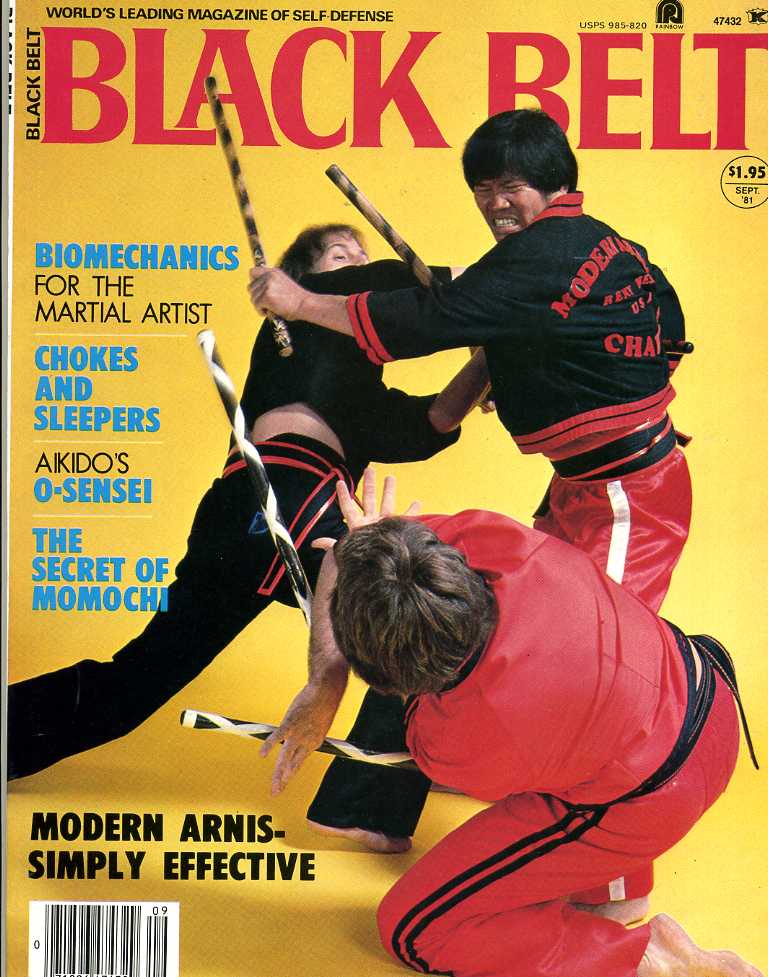
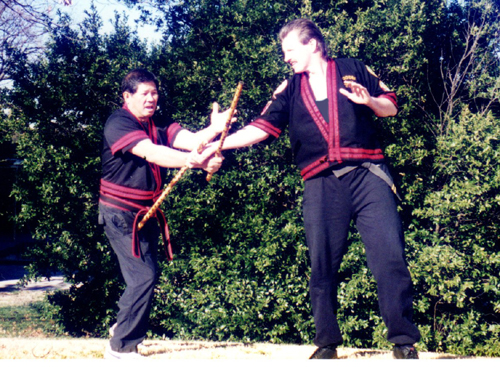
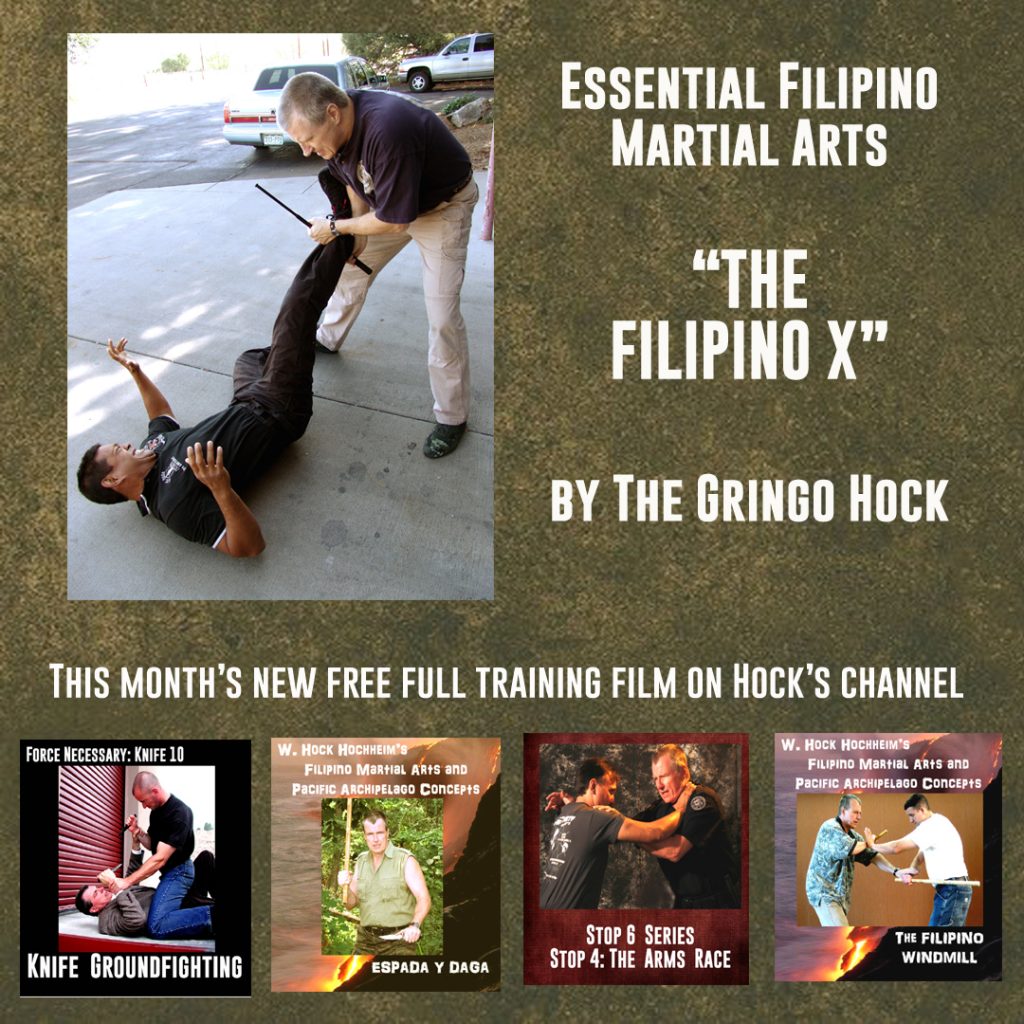



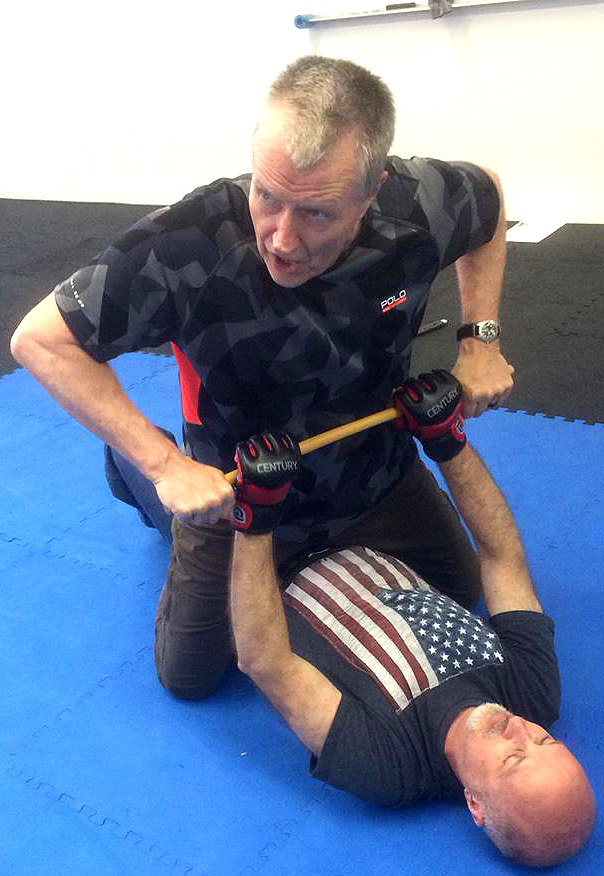
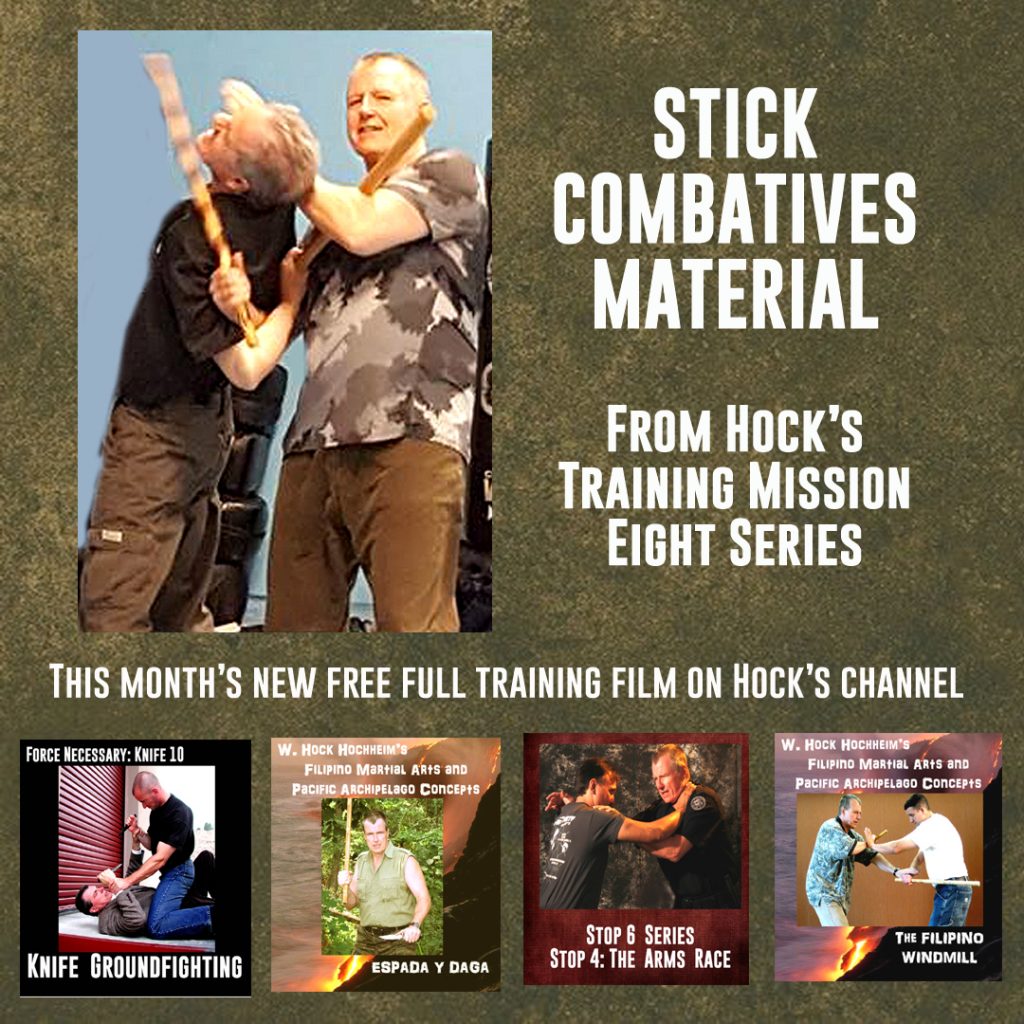
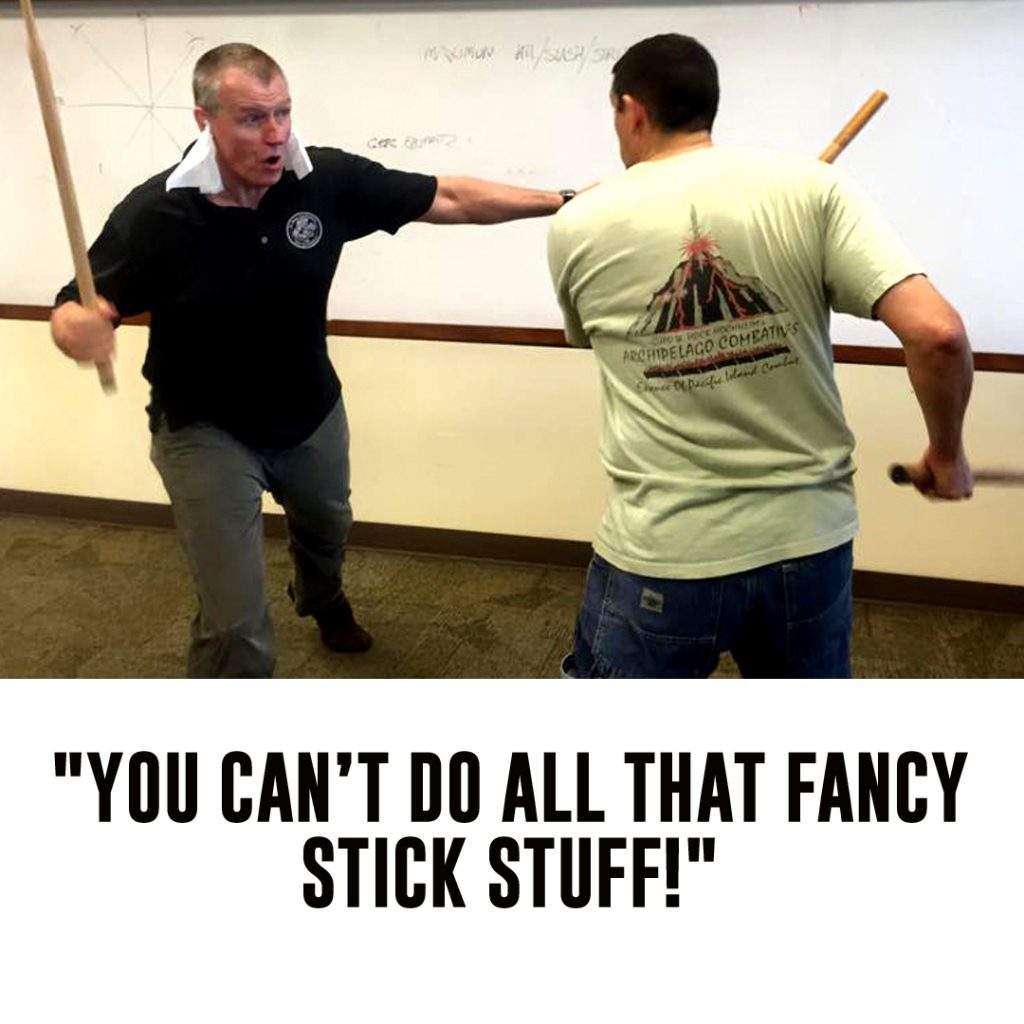 If you are a FMA “stick versus-stick-fighter,” I think, about…ohhh…80%…85% (?) of the stick material typical taught, thee so-called by many – “fancy stuff,” fancy follow-up stuff is meant for the seconds AFTER your opponent is busted in the head (no soft sticks and-or no helmets) or busted somewhere painfully vital, that will diminish his speed and brains. The head shot (or any real diminishing blow) is the missing link between sparring and the follow-ups.
If you are a FMA “stick versus-stick-fighter,” I think, about…ohhh…80%…85% (?) of the stick material typical taught, thee so-called by many – “fancy stuff,” fancy follow-up stuff is meant for the seconds AFTER your opponent is busted in the head (no soft sticks and-or no helmets) or busted somewhere painfully vital, that will diminish his speed and brains. The head shot (or any real diminishing blow) is the missing link between sparring and the follow-ups.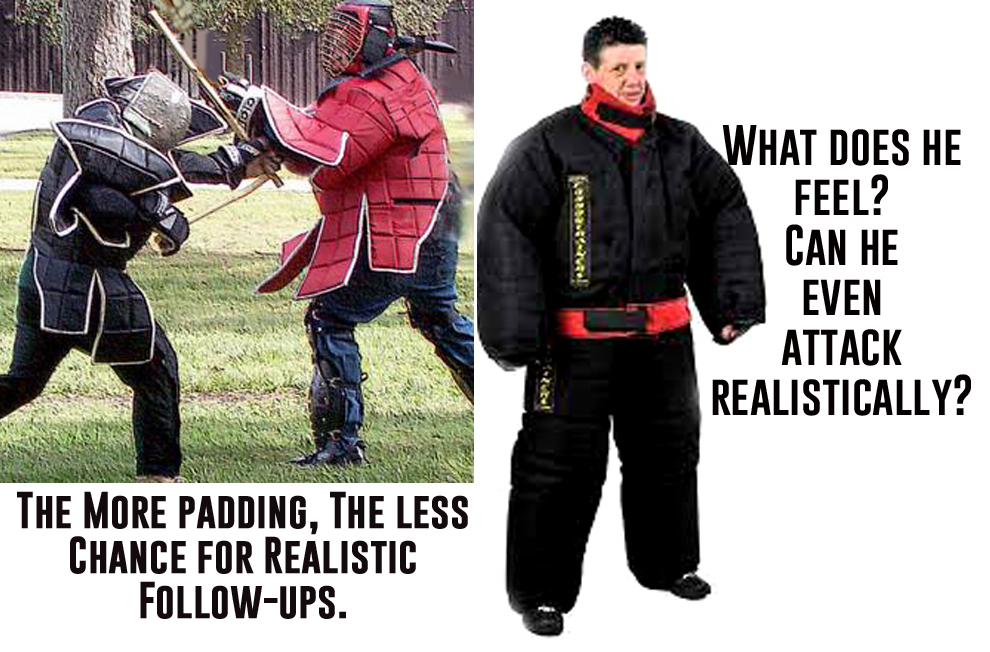
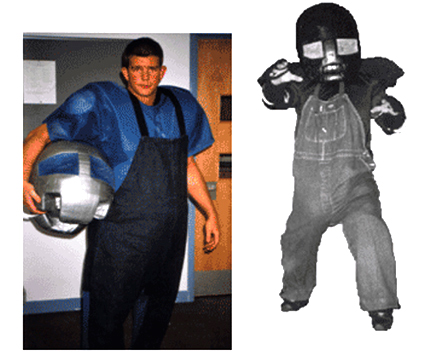
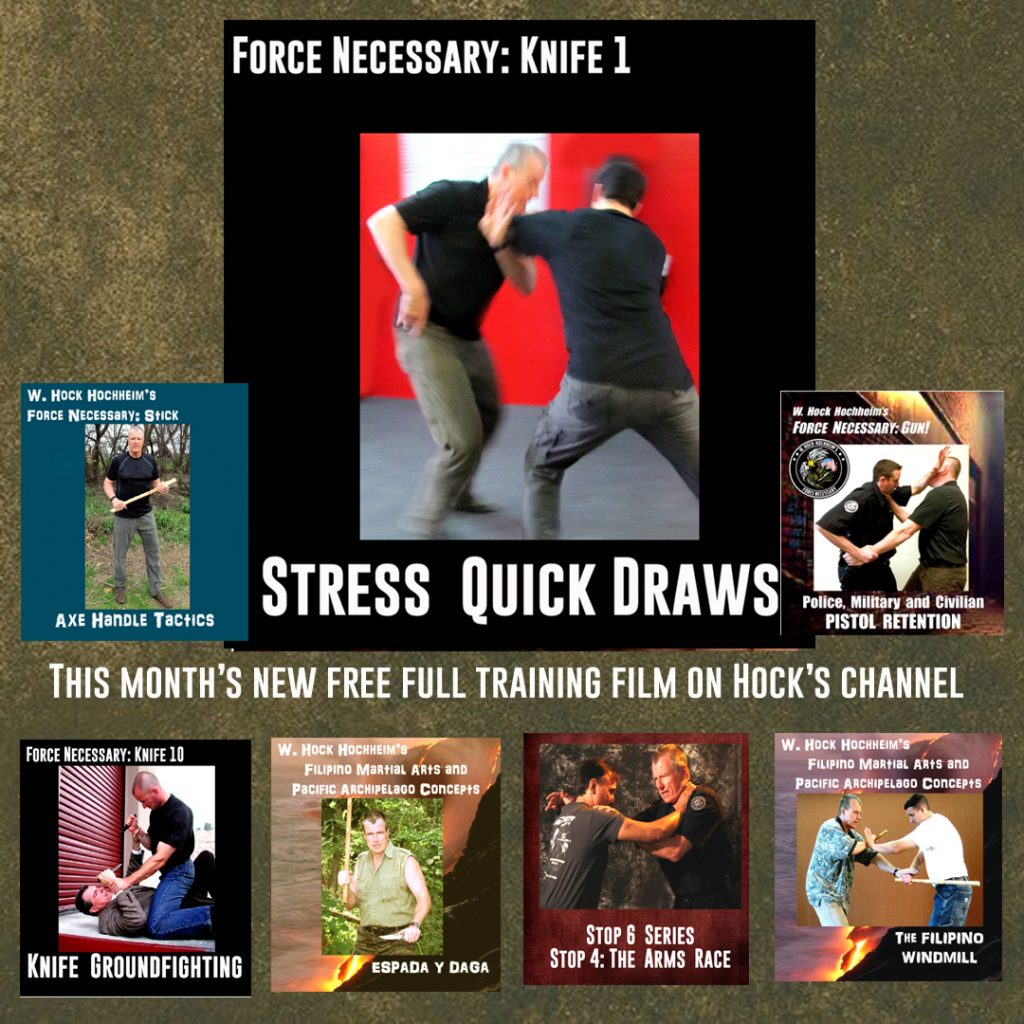
In the big picture of fast and furious, speedy, adrenalized stick fight, where does the single stick disarm exist? How can it? Let’s take a look. An important way I think for starters, is to first examine the overall Filipino Martial Arts (FMA) subject of stick versus stick disarming. I identify really only FIVE stick vs. stick disarm categories…in the universe!
Thus far for me, all the disarms in the universe, the galaxy (!) fit well into one of these 5 general categories above. Impacts and lots of circles and push-pulls, huh? Which is another way to help teach and summarize-explain the subject. List the raw movement concepts within the 5 disarm categories. Here are the three raw movements inside all the disarms categories.
I have had the opportunity to dissect and teach this list of 5 disarm categories (and their 3 movements within) around the world for years now and some, even semi-famous FMA instructors refused to believe this 5-list rendered, simplicity.
“How can it all be that simple? NO! It can’t be,” they sometimes say, “well then, what about this one?” they ask and show a disarm.
“Well that’s a strip and keep because you caught and keep this stick,” I would say.
“Well then, what about this one?” Demo…
“I would say, strip and send because shipped the stick away.”
And so on and so on, the challenges were fun to explore and always help me refine, refine, refine.
Five categories. Three raw ways to do them. Simple? Complicated? Traditional disarms are often taught and passed on in disorganized ways, usually created by artistic people with no scientific sense or teaching-organizational skills (like so many nutty katas, huh!). As a student in various FMA systems since the 1986, I have seen many of these disjointed disarm lists that miss the opportunity for smooth education, conformity and simple understanding.
For example, many disarms are glued to traditional angles of attack system. “Guro Jose” has 10 angles? And he demands – “Do this different disarm at each angle. And here they are. Memorize!” Many traditional disarms are passed along by doing…say…one mandatory disarm at their angle 5, (6, or whatever angle), when actually an angle 5 attack might be disarmed by 3 or 4 different ways. Best to pick a disarm category first and experiment doing it against all 10 angles. It will work sometimes and then not. One might call that process reverse engineering? This is a way to make your own list. Self-discovery experimentation is great, recognized, retention method.
Anyway, a search for easy, relatable explanations and mental retention must be conducted. But for many FMA systems and instructors, simplicity was-is not their mission, and after all, complexity is the fun – wow factor- cool goal. That fun, wow stuff, and-or then the regurgitation of their historic art is more important than say…the simple, sheer freedom to fix and improve things.
After the list of disarms with the 5 categories, understanding how they are executed with the 3 raw movements, it was time-saving and thorough for me to make the next list of counters to disarms. (For me, the counter study was really related to thwarting the 3 movements. What universal things could be done to counter them?)
OKAY! Quick Disarm Tip: FMA stick is primarily a play within the Rectangle and-or “X’” box, and-or figure 8 circle, areas in front of your body betwixt the two opponents. Not as many training attacks come down from straight above, or up from low-low (there are a few more low than from straight down, still not enough). How did I determine this? Just examine your system and other system’s angles of attack drills to check this. One or maybe two angles of their 8, 10 or 12 angles comes straight down from above. The rest are side-to-side thrusts or slashes in that rectangle. In Guro Jose’s system, only one angle came down from above, the other 9 were other attacks. This means his system by innocent doctrine, de-emphasizes the common from 12 o’clock high, downward attack! One out of ten. On these high and low problems…

“Hock, connect sticks high? Then force the contact DOWN to the left or right sides where there are more and easier disarms. Low? Connect sticks low? Then force the contact UP to the right or left sides where there are more and easier disarms.” (Okay! Did Moses bring that tip down on another tablet we didn’t see? It was very helpful, conceptually.)
Okay, back to making your own list and using it in sparring. Free and eclectic. You got your list! Next, can they be done fast? Under pressure? The subject of this essay! We can all do them slow, sure. But so, in the big picture of fast stick fighting-sparring, how does the proverbial stick disarm exist? Can it exist? I know a lot of veteran hardcore stick fighters and they say they hardly ever saw a semi-elaborate move. It seems that in a full-blown stick fight-sparring (but with protection-see below), all semi-elaborate moves and elaborate moves are very hard to do and hard even to see-find in usual stick sparring.
In the same way we only see…ohhh, what? Eight, ten basic, non-elaborate, fundamentals in UFC fights, over and over again, and nothing elaborate seems to manifest, because the elaborate is usually hard to insert in the world of full speed and adrenaline. (I might add the impact disarm is probably the most common?)
I have found that in order to fully understand the possibilities of disarming in full action mode, I had to cut stick fighting-sparring into two categories and understand “stun, no-stun.”
Stun, No-Stun? Protective gear or not, you can do a few more things, go a little deeper in moves, be a little more “semi-elaborate” when an opponent is stunned-wounded. (Some come to you diminished, are naturally slow, untrained, etc. like their stunned!) If very stunned? Then elaborate! Sooo, protection matters!
So, single-stick sparring within the Stun, No-Stun universe:
Stick sparring with sturdy helmets and protective gear frequently ends in grounded wrestling matches because of the protection and limited, reality stun factor. Much FMA stick-duel instruction is given under this art-sport umbrella. Stick sparring without any such gear at all frequently ends in an ambulance.
Disarms! Who or what, where, when, how and why…are you? These questions define your training mission, your end goal. They create the important nuances of doctrine (and disarming). I surmise that that many practitioners think about all or any bit of these points and just play around in the art for the wow, the fun, the hobby. Wow! Which is absolutely fine, I only ask folks…just…know what they are doing who, what, where, when, how and why.
__________
Hock’s email is Hock@SurvivalCentrix.com
Check all the free Hock FMA training films, click here
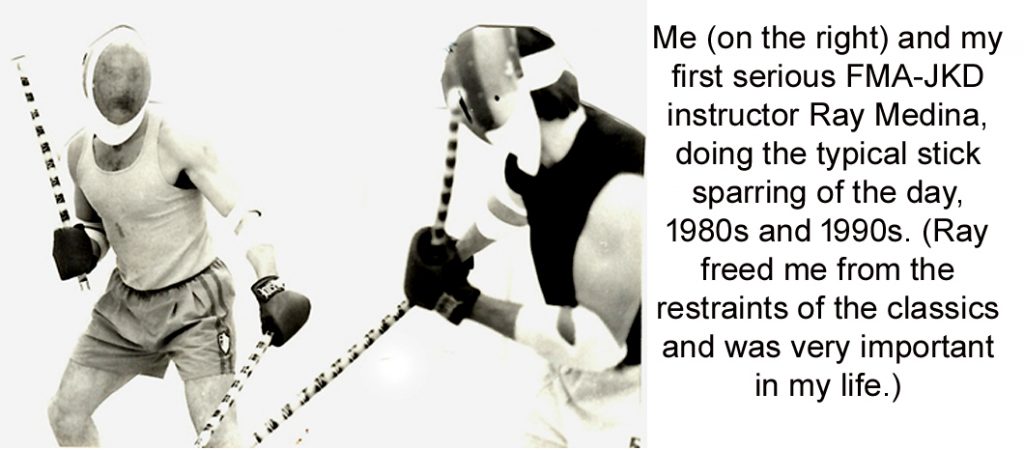 Respect the Head Shot? Do you? Really? One of the conundrums in FMA stick sparring is figuring out the realistic importance of the head shot and emphasizing it in a training doctrine. Ignoring the strike (as in “pretending” it didn’t happen and “sparring-on”) because you have a helmet on is training doctrine mistake. Making it “count” in a helmeted world is important and should be a mandatory training doctrine mission.
Respect the Head Shot? Do you? Really? One of the conundrums in FMA stick sparring is figuring out the realistic importance of the head shot and emphasizing it in a training doctrine. Ignoring the strike (as in “pretending” it didn’t happen and “sparring-on”) because you have a helmet on is training doctrine mistake. Making it “count” in a helmeted world is important and should be a mandatory training doctrine mission.

Okay folks. Bare with me. I have a few martial ranks through the years, (like a FMA, guro BB test in Manila). So, this is a joke but not a joke. I have a joke-meme I’ve passed around for years with two loaves of cut-open bread, a “white bread-brown bread” meme.
The idea is that “Joe Jones,” white boys will hardly ever achieve respected status in FMA. (I know a RARE few are, yes, yes, but most people look to and seek, foreign sources, certainly Filipino in FMA, but often settle for any American in the states with a “Spanish sounding” name. Or at least foreign sounding name. Exotic. Same is true for the rest of the planet. Think about it. Make a list and really think about it.
“The ‘hierba’ (grass) is always greener….”
And bland, white, Joe-Jones-Gringos (like me) take a back seat. This is not new, it’s a martial arts “universal.” Who wants to learn BJJ from a white boy from Finland? NO! Brazil! Or at least have a cool Hispanic or foreign surname! I’ll fall for that!
Eventually you will have to settle for a …”Gaijin” in your neighborhood. He or she may be fantastic, just not as well known, (and will remain unknown, which is actually the whole point of this essay).
All this is just the subliminal (and overt) marketing of life and what we seek out, like Chinese food, or Italian pizza and who makes makes the best cars? Germans or Japanese? Are ex-cons the best street fighters? Do the Israelis have the best military fighting system? Is Silicon valley the best source for all things tek? Why pick the Marines over the Army? People should recognize natural and man-made…”lures.” Who has the “best” story for what? And why? What then, catches our fancy? What do we gravitate to?
In fact, when I think about it, I have felt like a white boy (and-or wrong religion) outsider in most martial arts I’ve ever down, with all the real leaders always from elsewhere, Japan, Philippines, Indo, Russia, Israel, China, the sewers of Spain (gag)…the popular systems and arts are always from elsewhere. And me? Always the…gringo. This though I expected, it’s just an observation on martial life.
Anyway, there were numerous viewers of that “bread” meme on various pages, some very smart and substantial folks, and they laughed and liked it when I half-joked that I might therefore just call myself “El Gringo,” as part of an FMA business nickname, (I still teach FMA here and there around the world along with mostly combatives.) Just a fun, name-game and partly a bit of satire on all those grand, tuhon-guro-supremo-GM master titles that keep inching up like bamboo. For 26 years now, I just tell everyone I teach to call me “Hock” and remain on an equal, friendly footing as I believe system-head-worship is confining and not good for evolution. Bad for some of my business, but good for your evolution and freedom.
Some attendees-students still insist on titling me. It’s a tradition, you know. If you must call me something? Truth is, I’m just a gringo, a white boy, outsider from Texas who knows a few tricks of the trade. Tongue in cheek? A satire on the name-game? For FMA…call me…”EL GRINGO!”
“Out of the night, when the full moon is bright, comes the stickman known as Gringo. This bold renegade carves a “G” with his blade, a “G” that stands for Gringo.”
(Sung to the Zorro TV theme with apologies thereto. I realize the great young, unwashed has never heard the Zorro theme song. Never saw the old show. Too bad. Then feast! Feast on this video! https://www.youtube.com/watch?v=lQnle_3KuOE
________________________________________
Hock’s email is HockHochheim@ForceNecessary.com
Check out the PAC-Filipino page, click here
A Bigger Picture. In the martial arts world, stick versus stick fighting is most closely associated with the Filipino Martial Arts (FMA). A huge chunk of many FMA systems is indeed about the stick-versus-stick duels-events.
(Using-hitting a stick is an easy and fast training target, as with developing the smart fanning strike shown here – the abaniko. This is not necessarily learning how to stick duel, but rather learning to strike with a stick versus anybody with or without anything with a one-two-there fanning spin.)
To establish my opinion here, I remind that I have spent decades in FMA and decades in very generic combatives. Some people around the world think I am knowledgeable on the subjects, so here goes.
The best FMAs I’ve found spend equal amounts of time in what GM Ernesto Presas defined as “the 5 major areas of play” –
Equal time for the five? I find that some FMAs spend disproportionate amounts of time with sticks. Just look at all the group photos of FMA seminars. Everyone is always holding sticks. Sticks, sticks, sticks. Sticks have become the avatar for FMA. Sure it’s fine for some hobbyists, addictive even, whatever, but I “stick” with the Ernesto Presas “Big 5” format.
I am so often reminded of the classic Ernesto Presas quote, “The cane is the extension of the hand,” suggesting that the hand comes first. Dan Inosanto, so often pegged an a consummate FMA-er always does a plethora of other arts than being stick-centric. Too much stick gets FMA redefined to the “stick-only art.” It ain’t! It’s so much more.
Is this dueling calculus necessary in the real world? Through my decades of policing, training, cases and rather obsessive research, I have personally run across a few impact weapon “duel-related” battles like drunken, softball bat fights at tournaments, or crowbar versus tire iron fights. Things like that.
Stick dueling.Otherwise No. Almost all of us are highly unlikely to get into the proverbial 28” stick versus (coincidentally?) another 28” stick fight in a real world, dueling “street fight.” A study of the stick in common self defense should not-would not be centered around a mirror-image-fighter, stick-versus-stick dueling material. Secondly then, all this stick-trick trapping after longer range contact? No. Not this much. Obsessing with stick dueling and stick trapping should be relegated more into a category of fun, art, sport, hobby or exercise, with only abstract benefits to self defense.
While dueling helps various abstract attributes, there are indeed smarter things to do, to prep for a fight in crime and war. When you remove stick-versus-stick dueling and the calculus of stick trapping from FMA systems, there is so much less to worry about and train for survival. While It is vital to FMA, but even in FMA, there is always other stick things to work on like stick-versus hand, stick-versus-knife, even stick-versus-various, gun threats. Now we are looking like self defenders.
I am asked to teach FMA with some frequency and I do so with a great big smile as it is one of my fun interests, but I always make this quick lecture. As readers know by now, I preach the “mentality, hand, stick, knife, gun, mixed weapon, matrix.” And while my Force Necessary: Stick course must touch a bit on the impact weapon duel – because it has and can happen – in no way do I emphasize it. And a great many folks emphasizing self defense and combatives agree with me on this.
Watch out! These “reality” people are “window-peepers, peeping in your school windows, watching you on Youtube.” quick to judge what you are doing and pigeon-hole you as artsy and off-mission Arnis versus reality. Which leads me to the name-tagging quandary.
For self defense combatives, the trainer and trainee, the work-out partners should still both often hold sticks sometimes. Sometimes? In stick training, it is much easier and faster for both partners to hold sticks for various goals. You do, I do, You do, I do. Ease, target practice and stick blocking to name three.
(Target practice! And you can hit hard. He can learn to block well too In the FMA world other Arnis-Kali things happen.)
So even if you are a self defense, combatives person you might find yourself looking like an FMA-er when both the trainer and trainee hold sticks and appear to be doing “too much stick versus stick” to these short-term window peeper-complainers. But still, dueling is not your real, end mission.
In summary, a few quandary warnings to think about…
Obviously I use an impact weapon emphasis in my Force Necessary: Stick course (details listed below, the self defense, stick matrix,) but I do not overdue the stick versus stick aspect when covering that course. FN Stick looks like this:
When teaching FMA I try to do everything but in equal proportions.
Hock’s email is Hock@HocksCQC.com
_____________________________________________________
Get the Impact Weapon Combatives book, (the new second edition!) Click here
MMA – Mixed Martial Arts? Or MMA – Mixed-up Martial Arts?
The tabulators tell me that 2021 this will be my 51st year doing martial arts – having started in Parker Kenpo in late 1972. I’ve always 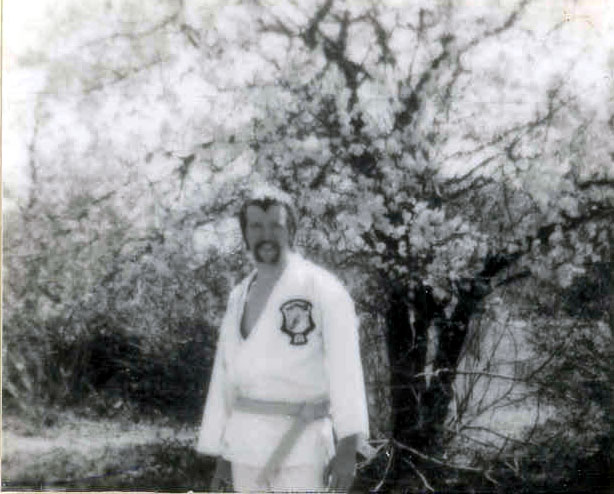
From the 70s on I was working out with what was available, old school jujitsu, boxing, karate, police judo-defensive-tactics. Then in 1986 I starting with the Inosanto Family systems (Thai-JKD-Silat-FMA-Shoot fighting) and Presas Arnis. In 1990 I started Aiki-Jujitsu with a professor in Oklahoma. I guess I was spinning a whole lot of plates? But on some level, despite the differing outfits, patches and the nomenclatures, many times I noted I was often doing the same basic, good moves in different systems, despite the change of systems with a tweak here and there. Sort of a name-game change.
Makes me think of the Bogey movie song, “You must remember this, a kiss is just a kiss, a sigh is…” But you really must remember that a 
I see my martial life that same 1, 2, 3 stages way that Mr. Qingyuan suggests, which leads me to my mixed-up-martial arts phrase and phase. Bear with me. You might see yourself in this dharma-dilemma-development?
For quite some time I played a name-game switcheroo. I changed clothes and mindset with various martial art class scheduling. Often in the same night! I can best describe this with two quick stories.
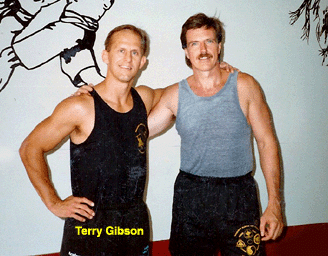
Each of the classes definitely had a different mission, feel and goals. I’d got the vague idea back then that these things could be blended, especially via the Bruce Lee ideology I was trying to grasp, 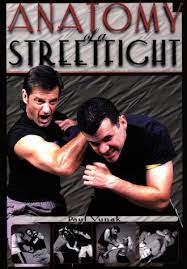
By the way, this division of subjects is a martial arts school business model. More classes. More themes. More students. More outfits. More testing. More money. Nothing wrong with that – just saying. With many other instructors and schools in this business model, we studied to become one system-artist when doing that one system-art. MMA, the evolved business model became closed studies to learn different things – yes – but, inadvertently, keep them separate. Divided. Which, whether I fully realized it at the time, was NOT what I wanted, but I wasn’t quite “martial-mature” enough to realize it. I had no “eye” for it. (More on “eyes” later…)
I used the Who, What, When, Where, How and Why questions.
While turning the all-mixed-up to the mixed-blended, I have a lot of teaching stories for each “W and H” question from these last 26 years, the second half of the 50. I believe these to be informational, entertaining and educational stories, but book-length, and not good here for a short blog.
It should come as no surprise that in the big training picture, modern MMA (as in a blended “UFC style” With ground n’ pound, and I repeat WITH ground n’ pound), Combatives or Krav Maga formats evolved to fill in that anxious, wandering market place of folks like my early self, seeking the stripped-down blend, the best mix. It’s just business and filling the gaps. “Nature abhors a vacuum,” as they say.
Something much bigger is going on though. In the history of mankind, its overall DNA, a small group of people – us – struggle to keep fighting skills perpetuating, alive, for the drastic times that come and go, and keep us all alive. This genetic drive manifests in many different ways, like karate or combatives. It’s that big picture, so big we don’t see it, down to the smallest of pictures. You. You and the quizzical questions and choices in your head. Why do you do this stuff? Well, I just gave you one big DNA reason you might not have thought of. For some of us? It’s our inherent duty to mankind. We are the odd, weird ones, keeping this alive.
I certainly don’t regret all the mixed-up, past exposure, the blood, sweat and cussing since 1972, even though I wanted simple, generic hand, stick, knife and gun. But still, the background-depth, time and grade, experience is irreplaceable. Mike Gillette said once, “you are really paying Hock…for his eye.”
His eye? Eye? Look for a moment at my Australian friend Nick Hughes, currently in North Carolina, USA. Yeah, he teaches Krav Maga, and yeah, so does every Tom, Dick and Henrietta these 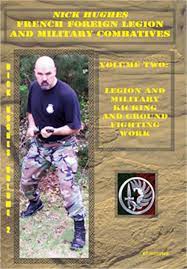
I often peruse the internet martial arts pages and I read stories of 25, 30 to 45 year old martialists and martial artists and their compulsion to publicly write – as one might in a personal journey or diary – about this or that small martial epiphany. Been there, done that, kid, and I quickly get impatient and bored with their tales which is my flaw, because I have to remember everyone is on their own splayed and fileted journey. Their mission, however on or off it might be.
What is your mission in this dharma-dilemma? Are you…”martial-mature?” How’s your “eye?” Look, I want people to be happy. Do what makes you happy, sports, art, combatives. Mixed? Mixed-up? Fun? Comradery? Whatever. People even like all kinds of mixed-up, martial arts to fool around with! Just know where it all fits in a big picture. Your big picture.
The teacher’s curse, “Survival? Or addictive hobby?” “In the martial arts world – There is so, so much to do and so, so much of it is addictive, but so much of all that addiction is extraneous, superfluous, abstract, distracting and unnecessary. Yet still this curse – the mandatory basics become boring, no matter how utterly important it is to utterly master them and them alone. It seems we will never stop wrestling with this fight against boredom. The “art” of the survival teacher is to find the best, reduce the abstract and somehow trick-hypnotize-engrain the student into doing it…first, foremost and forever.
You can use your mature eye to take the “mixed-up” out, and to leave “mix” in. You can take things from a martial art that has a high percentage of success and NOT take the whole damn system. Or not? Just don’t be…off-mission, off your personal mission. In the mixed up, forked roads of martial dharma – the “eyes” have it.
____________________________
Hock’s email is HockHochheim@ForceNecessary.com
A lot of American football coaches and players watch game films. I instead, have watched hours of football “how-to” training films to see how these players TRAIN. If you have ever spent time with me, you’ve heard me brag for years, decades even, on how American football training methods can be diced and altered to enhance, inspire and supply power-contact exercises for martial fighting. You’ve heard me say that a knife fight might not look like a movie duel, but might instead look like “football with a knife.” Same with sticks.
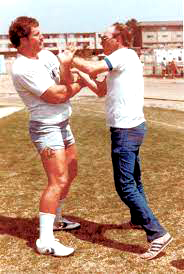
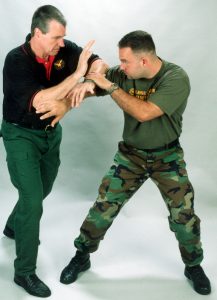

So, I take a hard look at football, hand drills-methods that enhance all that. The of quality football players, starting at college on up, is record breaking incredible now. These increases come from several methods, but two methods are clever drills and exercises for functionality.
One Quick Observation in and around on this subject. Australian football – or “Footy” is tough as hell, and like Rugby, sort of like soccer, are “chase-games” without the consistent line of scrimmage collision battles that can be reminiscent of, and can resemble a common collision in a fight, crime or war. Every football play starts with what a chiropractor might call, a small car crash.

Second Quick Observation in and around this subject. A fad move today is teaching an arm drag to get outside of an opponent’s arms and then pivot around them to get a rear bear hug. In demos and seminars, many “show-ers” just…just end right there with the rear bear hug. They show no more. Huh? They stop there, as if, with the bear hug it’s…over? Nope, it’s just getting started. Yet naïve rookie, seminar attendees (usually gun guys exploring unarmed combatives) think its manna from heaven. Some instructors will show a follow-up. They demo a bear-hug follow-up solution and they will lift up and body slam the opponent to the ground, of course falling with them too, to enter into the world of non-stop, one-dimensional wrestling. Such is their brain-washing. Usually both these demo people are 30ish-year-old athletes. But when we look around at ourselves, at each other, differing sizes, ages and strengths, is a 150 to 250 pound body lift and body slam of the enemy practical for the masses? Hell no. I can’t pick up, least of all, body slam a 175 or 200 pound person! And anyway, I want to remain up as much as possible.
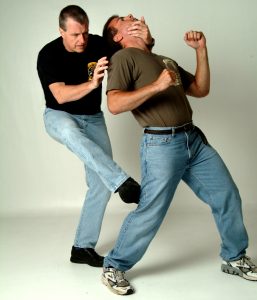
A Third Quick Observation in and around this subject. American football obviously deals with face-to-face, frontal to frontal tackles, and not always chase tackles. They also cover power drills with pads to counter tackles, done in clever ways that any citizen should try and would enhance the subject, beyond typical martial arts classes.
In Summary, The Problem Is, His Arms! They are almost always are in the way. And they have muscles and seem to have a “mind of their own!” Here is a fast, short list of some football training drills I have collected on trapping and the “Football-Hand-Fight.” I can’t put videos in a book so I have to share them here. They incorporate Stop 3 Forearm Collision materials, and Stop 4 Shoulder Line collisions. Would you watch them for training ideas, adaptations, and inspirations?
For more diverse training…
HANDS-LANDS – Touching the “hands” of the master. Touching the “lands” of the master. Hands-Lands.
(This was a spirited discussion on FMA Discussions. Many say you MUST go to Philippines to “get it.” Many say no. Not needed. I said…)
I started attending Remy Presas seminars in 1986 and I was just another person in the crowd. One attendee was also an Ernesto Presas guy who asked me if I knew Ernesto. I did not and he pulled me aside into a curtained-off meeting room from the big seminar. Two others were there too and we started doing Ernesto stuff. This guy trained me in Ernesto’s material for years, which is different than Remy’s. Four or five years later we wound up in the Philippines. Once back in the USA, at the next Remy seminar, attendees told Remy I was over there for three weeks and even stayed at his old Negros house, etc. He liked this, called me over and wanted family gossip and so forth and only then did we made the solid connection, because he knew I was THAT committed to go over there. I started hosting Remy for years, etc.
Later at a Remy-Dallas seminar at Steve Selby’s school, Remy made a speech about training and with whom and “Touch hands with the master,” or as he would say it, “Touch hans’ TO de’ master.” He pointed to me and said, “Hock has gone twice to de’ Philippines already. I don’t know why? Because…I am here!” Everyone laughed as did I, shaking my head. You could tell by his smile that he making a joke. But why go?
The pro-go Filipinos in the FMA Discussion seem to want you to see the lands, walk barefoot on grounds, breathe the air, eat the food, dive deep in the history otherwise you won’t really “get it.” Like live there? “Going native” – is “to adopt the lifestyle or outlook of local inhabitants. Furthermore, must we also “go native” with all these martial arts we take? While Bruce Lee said all these things were just “Kicks and punches,” must we go down a national rabbit hole and become Colonel Kurtz? I went a little native in South Korea. Lived in the village, etc, but didn’t become a Kurtz. The military grants you time and grade in obscure locations, otherwise you are in-and-out tourists.
Tourists. I often look at folks traveling to the homelands of their martial arts. So many go to Okinawa, Tokyo. South Korea. A friend of mine even went to NORTH Korea for a Tae Kwon Do pilgrimage! (He said it was scary.) All serious Thai Boxers go to Thailand (although in my “heyday-times” of Thai -1990s- many also went to Scandinavian countries for Thai). I think it’s a pilgrimage some want to take. I think it is situational and circumstantial. After my P.I. trips, we got Ernesto coming over the states with gigs and the P.I. trips were long and expensive for me (and my job). The circumstances, the situation, the need was over. But I will confess, me having “gone over” several times was a big marketing help for me.
People like to travel and touch for really unique reasons, lest of all over martial arts. I have a good friend in England who worships the Spaghetti Westerns of Clint Eastwood. He and his wife visited the small town village in Tabernas Desert and the Cabo de Gata-Níjar Natural Park in Spain where they were filmed. He has small glass jars of the sand from there as souvenirs. The human drive to visit.
Look at all the people running to Israeli for religion and Krav! The Japanese see Americans going over and dressing like they are ninjas and they laugh. One Japanese-American told me it would be like Japanese coming to America and dressing up in Civil War clothes and taking part is a Civil War recreation. WHY!?
I like for people to be happy and if they want to go, and afford their journeys if they can and should go. I would like to go to Frank Sinatra’s house in Palm Springs. I might not get a glass jar full of booze, but I would like to sing a song there in the backyard.
What of the name-game and FMA? This is actually a whole other FMA discussion subject, somewhat related though, but the real success stories in FMA, those with sought-after instruction and with bigger groups are really all Filipino people. Or they have a name-game-stretch-connection, with Spanish or exotic sounding names yet have never gone to motherlands. Dan Inosanto, a real important FMA pioneer, has never been to the Philippines that I recall. How many land-locked, Americans just have exotic foreign names and have large groups? (They could be good or bad but still get the immediate attention.)
Even though I have been over there – this is why I do not flash myself around as some kind of special super-duper, FMA Person. I will never be an FMA real deal. I am happy to help others get an understanding, etc, if they are interested, but I am just a white boy in Texas. I can only think of a very few white boys with consistent, international FMA success, oh like Bill McGrath and Deiter Knuttel from Germany. Otherwise you gotta’ be Filipino or have a Spanish sounding name and,or seem to be Filipino or could be Filipino. Or else, you better be seriously attached to one. The truth (skill) bears out later.
Origins and names…this is a universal, martial idea-draw. As a parallel, looking at ads and videos would you want to take Brazilian Jujitsu from a Tim Smith? Or a Jose Gonzalez? Who has the immediate advantage? Most would instinctively go with the Jose. (Makes me think, speaking of other parallels – how many Yankees are going down to Brazil to learn BJJ, to go “native” in that native homeland, or have all the experts moved up North?).
On “Going native,” furthermore, must we also “go native” with all these martial arts we take? I do think back through the years of Systema people getting so wrapped up in it that they started becoming communist. Posting pictures of Putin and remarking in pro Russia statements. How some Silat people became Muslim? And then even radical Muslim. I’ve seen it. Krav people becoming Jewish. Like Bruce Lee said – all these things were just, “Kicks and punches,” must we go down a native rabbit hole and become Colonel Kurtz? Studying how to kick and punch should not ordinarily alter your politics and religion.
Touching the “hands” of the master. Touching the “lands” of the master. Hands-Lands.
__________
Hocks email is HockHochheim@ForceNecessary.com
Don’t let this photo scare you! Click here and check out the PAC-FMA streaming videos
#marlonbrando #apocolypsenow #franksinatra #spaghettiwestern